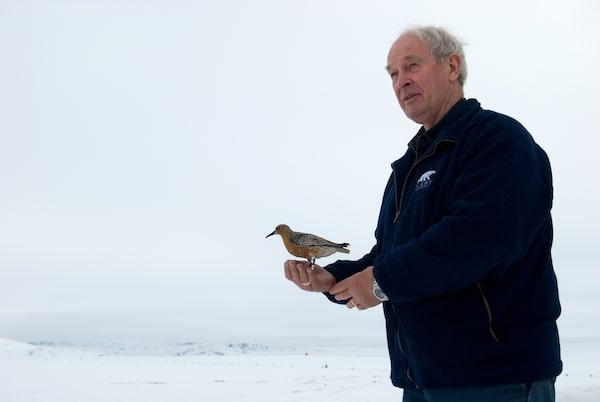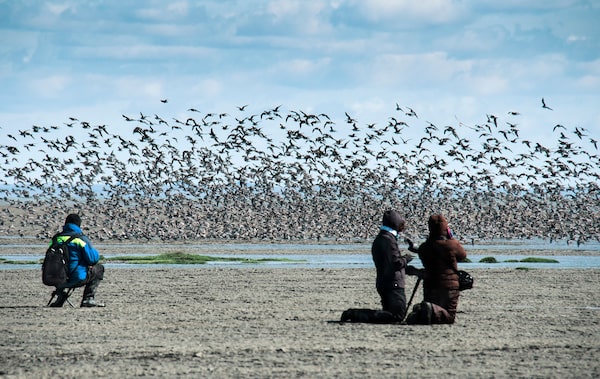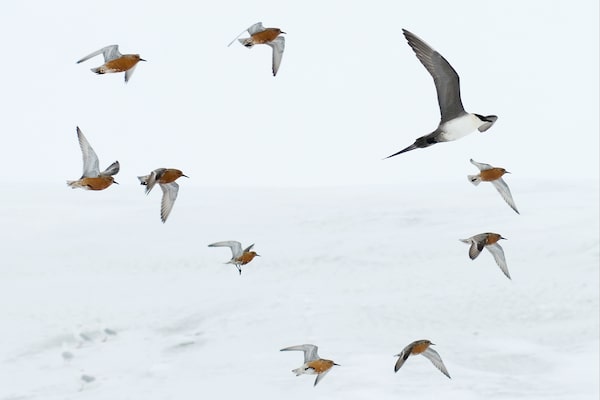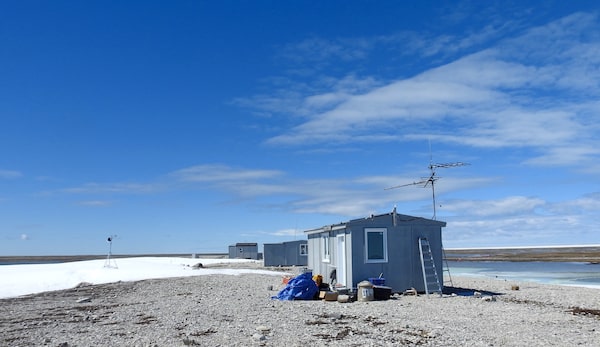If you look closely, you can see a long, hair-like antenna extending from the back of this red knot. The antenna, attached to a nanotag on the bird's back, emits signals that are giving researchers a detailed look at how the birds make their perilous migratory journey.Yves Aubry/Environment and Climate Change Canada
Christian Friis snips a few speckled feathers off the back of a shorebird, a biological marvel known as the rufa red knot. Then he dabs a drop of glue on a tiny electronic tag and sticks it on the remaining base of the feathers, plugging the bird into a tracking system that follows knots on one of the most perilous journeys in the world.
“Count to 30 so the glue can dry, then let it go,” Mr. Friis, a biologist with the Canadian Wildlife Service, instructs an assistant whose hands are wrapped around the robin-sized bird. When she sets the bird on the sand, it shudders, extends its sleek wings and vaults into the air. In a few wing beats, the bird is gone, the “nanotag” taking a Canadian-U.S. research team along for a virtual ride.
The device will be picked up by the Motus Wildlife Tracking System, which is managed by Bird Studies Canada, a science-based conservation group, and is one of many that are providing unprecedented detail on the travels of shorebirds such as the knot, which makes one of the longest migrations in the animal kingdom. Signals from the nanotags showed knots sweeping north over the U.S. border and Southern Ontario in early June, cruising along at 50 to 60 kilometres an hour as they stream past Philadelphia, Rochester, Toronto and Kingston. One bird made the 1,424-kilometre flight from Delaware Bay on the U.S. coast to James Bay in just 18 hours in 2015, surprising even scientists who have long known knots are something special.
“They’re a miracle of biological engineering,” team member Guy Morrison, scientist emeritus at Environment and Climate Change Canada, said of the shorebirds, some of which have been known to fly farther in their lifetimes than the distance to the moon.

Guy Morrison holds a newly banded red knot in Ellesmere Island, Nunavut. A white 'flag' on its upper left leg indicates that it was banded in Canada.Clare Hodgetts / mophoto.ca
Knots, which breed in the Canadian Arctic and winter as far south as the tip of South America, weigh about the same as an iPhone and transform into flying machines in the spring, weaving north through the Amazon to the northeast coast of South America. Trackers show the birds then venture out over the heaving Atlantic bound for the United States on long-haul flights of up to seven days, without food or water. To lighten their load on the long-haul sections and save energy, they absorb leg muscle and part of their intestines, which they later regrow.
Shorebirds, a diverse group of dozens of species ranging from tiny least sandpipers to long-billed curlews, have a distinct preference for wetlands, open landscapes and shorelines.
The birds are so tuned to the natural pulse of the planet that they know where and when to touch down on their ultramarathon migrations. As the climate shifts and key habitats shrink and degrade, researchers say the migrations are growing more dangerous, and more deadly. Many long-distance migrants are in serious decline, including the knot, which is listed as endangered in Canada.
The scientists hope the data from trackers will help them determine where to focus their conservation efforts.

RECORDED FLIGHT PATHS OF THE RED KNOT
2014
Flight paths
Canada
Tracking towers
U.S.
0
500
KM
2015
Canada
U.S.
0
500
Mex.
KM
2016
Canada
U.S.
0
500
Mex.
KM
2017*
Canada
U.S.
0
500
Mex.
KM
*2017 data is incomplete
MURAT YÜKSELIR / THE GLOBE AND MAIL, SOURCE: DATA PROVIDED BY BIRD STUDIES CANADA'S MOTUS WILDLIFE TRACKING SYSTEM
WITH CONTRIBUTIONS FROM COLLABORATING RESEARCHERS AND ORGANIZATIONS

RECORDED FLIGHT PATHS OF THE RED KNOT
2014
Flight paths
Canada
Tracking towers
U.S.
0
500
KM
2015
Canada
U.S.
0
500
Mex.
KM
2016
Canada
U.S.
0
500
Mex.
KM
2017*
Canada
U.S.
0
500
Mex.
KM
*2017 data is incomplete
MURAT YÜKSELIR / THE GLOBE AND MAIL, SOURCE:
DATA PROVIDED BY BIRD STUDIES CANADA'S MOTUS WILDLIFE TRACKING SYSTEM WITH CONTRIBUTIONS FROM COLLABORATING RESEARCHERS AND ORGANIZATIONS

RECORDED FLIGHT PATHS OF THE RED KNOT
2014
2015
Flight paths
Canada
Canada
Tracking towers
U.S.
U.S.
0
500
0
500
Mex.
KM
KM
2016
2017*
Canada
Canada
U.S.
U.S.
0
500
0
500
Mex.
Mex.
KM
KM
*2017 data is incomplete
MURAT YÜKSELIR / THE GLOBE AND MAIL, SOURCE: DATA PROVIDED BY BIRD STUDIES CANADA'S MOTUS WILDLIFE TRACKING SYSTEM WITH CONTRIBUTIONS FROM COLLABORATING RESEARCHERS AND ORGANIZATIONS
The eggs in the sand
Dr. Morrison and his colleague Ken Ross at the Canadian Wildlife Service flew the remote coast of South America in small planes in the 1980s, searching for Arctic shorebirds’ winter haunts. “I’ll never forget that moment we were flying up the Strait of Magellan and saw this huge flock of knots rising off the flats,” Dr. Morrison said.
Until 2000, about 50,000 overwintered in Tierra del Fuego, which straddles Chile and Argentina. Then the population, which he says appears to be genetically distinct from knots that winter in northern Brazil and Florida, “crashed.” There is no indication the birds moved or are making a sustained recovery. In January, Dr. Morrison and a survey crew counted just 9,840 knots in Tierra del Fuego, a new low and an 80-per-cent decline since 2000.
To understand the threats, researchers have stepped up efforts to track the birds, gluing nanotags on more than 1,200 knots since 2014 to follow them from the Eastern Seaboard to the Arctic and back. In January, 83 more knots were caught and tagged in Tierra del Fuego to try get a clearer view of the entire 15,000-km migration.
Come May, the birds should drop onto the shores of Delaware Bay, a key refuelling stop bordered by Delaware and New Jersey, just as horseshoe crabs crawl up from the ocean depths to breed and bury their tiny green eggs in the sand.

RECORDED ROUTE
OF A SINGLE RED KNOT
Starting and ending in Delaware Bay, U.S.
Southhampton
Island
Arctic Circle
Port Nelson
James Bay
Delaware Bay
Left: June 1, 2014
Arrived: May 17, 2015
Sao Luis, Brazil
Arrived:
Aug. 18, 2014
Lagoa do Peixe
National Park,
Brazil
San Antonio Oeste,
Argentina
Antarctic Circle
Tierra del Fuego, Chile
Arrived: Oct. 12, 2014
MURAT YÜKSELIR / THE GLOBE AND MAIL
SOURCE: BIRD STUDIES CANADA

RECORDED ROUTE
OF A SINGLE RED KNOT
Starting and ending in Delaware Bay, U.S.
Arctic Circle
Southhampton
Island
Port Nelson
James Bay
Delaware Bay
Left: June 1, 2014
Arrived: May 17, 2015
Sao Luis, Brazil
Arrived:
Aug. 18, 2014
Lagoa do Peixe
National Park,
Brazil
San Antonio Oeste,
Argentina
Antarctic Circle
Tierra del Fuego, Chile
Arrived: Oct. 12, 2014
MURAT YÜKSELIR / THE GLOBE AND MAIL
SOURCE: BIRD STUDIES CANADA

RECORDED ROUTE OF A SINGLE RED KNOT
Starting and ending in Delaware Bay, U.S.
Arctic Circle
Southhampton
Island
Port Nelson
James Bay
Delaware Bay
Left: June 1, 2014
Arrived: May 17, 2015
Sao Luis, Brazil
Arrived:
Aug. 18, 2014
Lagoa do Peixe
National Park,
Brazil
San Antonio Oeste,
Argentina
Antarctic Circle
Tierra del Fuego, Chile
Arrived: Oct. 12, 2014
MURAT YÜKSELIR / THE GLOBE AND MAIL, SOURCE: BIRD STUDIES CANADA
The eggs are so easy to digest and rich in fat that the birds can replace the caloric loss from the journey from South America and double their weight in just two weeks, says New Jersey biologist Larry Niles, who co-leads the tracking effort in collaboration with Canadian and U.S. wildlife agencies, academics and non-profit conservation groups. Every spring for 20 years, his team has seen emaciated knots arrive with bones protruding from their feathery chests and watched them transform into butterballs ready to lift off to the Arctic. That is, Dr. Niles said, as long as they can find enough eggs. Studies show that birds that don’t double their weight are less successful on the breeding ground.
Changing climate is widely seen as a major and growing threat to shorebirds. They are expected to face more intense storms as they sweep over the continents and more unpredictable weather in the Arctic, which some scientists are suggesting could mean the peak hatch of the insects the birds eat on the tundra might come before the chicks hatch.
But for knots from Tierra del Fuego, the scientists say the biggest threat is overharvesting of the horseshoe crabs. “People used to haul them off the beach by the truckload to use as fertilizer and fish bait,” Dr. Niles said.
He and his colleagues are calling for more sustainable crab management, bolstered by studies and tracking data that show the crabs are crucial to the endangered knots.

Members of a Canada-U.S. tracking team check out a flock of red knots rising off the tidal flats in Tierra del Fuego, at the tip of South America, in January. They eventually caught and nanotagged 83 of the knots, enabling them to track the migratory journey to breeding grounds in the Canadian Arctic.Antonio Larrea

Red knots and a long-tailed jaeger fly over the snowy tundra of Ellesmere Island, Nunavut. Jaegers are agile flyers that will prey on young shorebirds such as knots.Clare Hodgetts / mophoto.ca
Nanotags and geolocators
Delaware Bay is “the hinge on which red knot survival swings,” Dr. Niles said.
When last year’s cool, stormy spring delayed both the crabs and the knots, he could be found pacing the beaches like a worried parent, scanning the horizon with binoculars and wondering: “Where are they?”
He feared the knots would not have time to refuel before they needed to move on. “They have to be in the Arctic to lay their eggs by mid-June,” Dr. Niles said. “It’s a very tight window.” About 18,000 birds from various knot subgroups arrived by the end of May, flashing their red breeding plumage as they settled in scattered flocks along the shore. The knots joined laughing gulls and other shorebirds frantically pecking up what eggs they could find, sand flying as the birds ran past, sometimes right over, crabs flipped and stranded by the waves, their barb-like tails and arms softly clacking as they moved back and forth.
When Dr. Niles and his crew spotted a large flock of knots, they buried a net the size of a tennis court in the sand and waited for the rising tide to nudge the birds up. Explosive charges sent the net flying, trapping 260 birds, mostly knots and ruddy turnstones, which hopped around like popcorn beneath the mesh.
The crew quickly untangled the birds and stuffed them in covered boxes. Each was weighed and measured as part of an annual monitoring project, and banded with coded metal rings and plastic leg flags, markers that have long been used to study birds’ movements. B95, perhaps the world’s most famous knot, named for the code on its orange leg flag, was spotted several times over more than 20 years as the birds migrated between Argentina and the Arctic.
Ever-shrinking tracking devices are providing a much more detailed picture. “Tracking tags are absolutely revolutionizing our understanding of migrant birds’ behavior,” says shorebird biologist Paul Smith of Environment and Climate Canada, who co-ordinates the project tracking knots using nanotags and geolocators to better understand their ultramarathon flights, their key feeding and refuelling stops and breeding success on the Arctic barrens.
Geolocators attached to the legs of almost 200 knots are about the size of a dime and record sunrise and sunset daily. The data have enabled the scientists to trace the birds’ travels and days-long flights over the ocean, some of the birds powering through storms and around hurricanes. The problem with geolocators is the data can be retrieved and devices removed only when – and if – the bird is recaught.
A big advantage of nanotags is that they do not have to be retrieved. Long, hair-like antennas on the tags emit signals picked up whenever the birds fly within 15 km of one of about 400 receivers deployed across the Americas as part of the Motus system. The tags, which cost about $200 each, weigh as little as 0.2 grams and fall off when the birds molt their feathers. Motus is following many kinds of birds, but shorebirds are a big focus.
Scientists say studies have shown the devices do not harm the birds.
Mr. Friis, in Delaware Bay last spring to deploy nanotags for the team, made it look easy as he calmly glued pearl-sized nanotags onto 40 knots in less than two hours. He crosses paths with many of the birds again in Northern Canada, overseeing shorebird surveys at their refuelling stops in James Bay, where tens of thousands of shorebirds frequent the expansive mudflats to feed on clams and mussels. Knots are more spread out and more easily spooked at James Bay than they are at Delaware Bay, where tight flocks run in front of beach houses. (Farther north on the Arctic breeding grounds, the knots are so elusive that predators – and people – are hard-pressed to find their nests hidden on windswept gravel ridges.)
A red knot with a nanotag glued to its back. The tag will be tracked by the Motus system until it falls off when the bird molts and loses the feathers.Yves Aubry/Environment and Climate Change Canada
What the trackers say
Nanotags show the birds waste little time after leaving Delaware Bay, streaming past several cities from Philadelphia to Toronto bound for James Bay and points north. On the return trip in mid to late summer, they fly south over the boreal forest heading for Quebec’s Mingan Archipelago, the Bay of Fundy and the often-congested beaches along the U.S. coast.
Detailed flight paths cannot come fast enough for the wildlife experts working to bolster conservation efforts. Wind turbines can be turned off to protect them. Beaches can be closed to walkers, dogs and vehicles when the winged migrants pass through. Mr. Friis says it can make a real difference, as shorebirds need to feed almost constantly to fuel their travels and should not be disturbed.
The trackers have revealed a previously unknown shorebird stop on the remote west coast of Hudson Bay near the Nelson River where many tagged birds feed. Dr. Smith suspects the hydroelectric development on the Nelson River is “changing the melt dynamics in the spring, drawing birds in when the area is still otherwise gripped in ice and snow.” That may not be a bad thing for the knots. However, the snow geese that also breed in the Arctic have exploded in number because of changing U.S. farming practices. They are chewing up so much habitat the biologists suspect they could be affecting shorebirds along Hudson Bay and farther north on their breeding grounds.

A Motus tracking tower is perched on the roof of this federal research station in northwestern Hudson Bay, on Southampton Island.Margaret Munro
Tracking is also providing insight into the “decisions” knots make during migration and how their difficulties mount when they do not get enough to eat along the way, said Sjoerd Duijns, a biologist at the National Wildlife Research Centre in Ottawa, who has analyzed everything from arrival and departure times to wind speeds during migration of 254 nano-tagged knots.
Most of the knots lift off from Delaware Bay in the late evening when predators such as falcons are asleep, Dr. Duijns said. The top knot speed recorded was 127 km an hour, but he says most of the birds flew a more leisurely 50 to 60 km/hour as they headed north, riding winds one to three km above the ground.
He says knots that were heavier and “fully fuelled up” tended to wait for more favourable winds, and travelled 25 km/hour faster, than leaner knots on the way to the breeding grounds, where extra fat reserves can be lifesaving as the birds often have to wait out snowstorms before laying their eggs. The chubbier knots also arrived earlier (an advantage when jostling for territory and mates) and left up to a month later, suggesting they successfully bred and stayed on the tundra to rear young. They were also more likely to survive to make the long journey south to an increasingly uncertain future for red knots and many of their kin.
“Almost all the long-distance shorebirds are in decline,” Dr. Duijns said. “An indicator something is wrong with the world.”